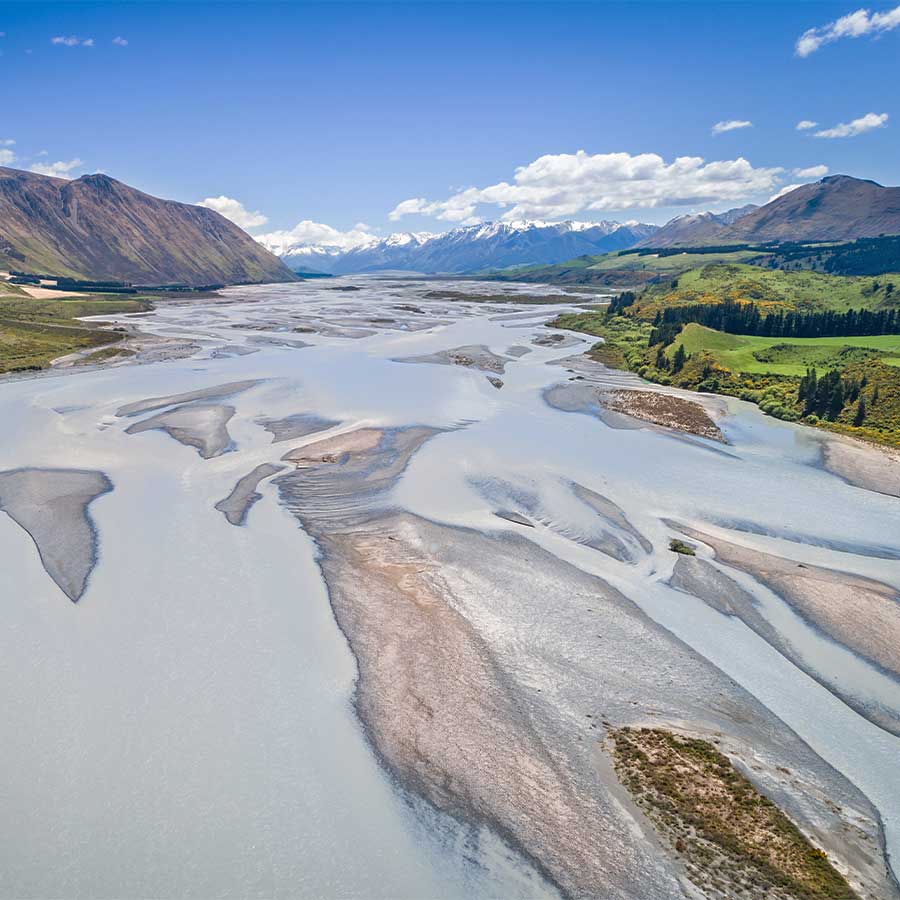Read about how we protect the region's rivers and biodiversity from weed infestation.
Braided river protection work
Regional councils have a range of roles and responsibilities when it comes to managing braided rivers; regulation, land management, biodiversity, biosecurity, and flood protection are all activities that contribute to sustainable management of braided rivers.
Taking a holistic approach to the health and vitality of our rivers is critical.
By engaging with communities and partnering with mana whenua and key stakeholder groups, we can accelerate regeneration of the natural environment and lead climate change resilience for Waitaha/Canterbury.
Our roles and responsibilities
- The Canterbury Water Management Strategy (CWMS), a collaborative framework that aims to halt the decline in ecological and biodiversity values through its targets and goals with a focus on the integration of water and land management, including the protection of indigenous biodiversity and water quality. One of the key CWMS targets is maintaining the natural character of braided rivers.
- Some of our region’s Water Zone Committees have also identified braided rivers as priority areas in their Zone Implementation Programmes (ZIPs) – non-statutory plans developed in collaboration with the community aimed at providing overarching goals for water management in the ten different water zones of Waitaha/Canterbury.
- The Canterbury Biodiversity Strategy, a region-wide vision shared by 22 Canterbury organisations which recognises braided rivers as naturally rare or distinctive ecosystems warranting protection. This strategy is a non-statutory document that establishes a framework of goals and priorities for undertaking biodiversity initiatives.
- The Canterbury Regional Policy Statement provides an overview of the resource management issues in the Canterbury region, and the objectives, policies and methods to achieve integrated management of natural and physical resources. These methods include directions for provisions in district and regional plans.
- The Canterbury Land and Water Regional Plan aims to provide clear direction on how land and water are to be managed in the region. This includes providing objectives, policies and rules that specifically manage activities in rivers and their margins.
- Environment Canterbury owned land - we administer land in river environments for river control and soil conservation purposes and income generation to support those activities (endowment). Some of these areas are used solely for flood protection and some have long-term leases or grazing licenses. Other areas are forestry, regenerative native areas and Regional Parks.
- We manage 58 river control drainage schemes through the Flood Protection and Drainage Bylaw. The bylaw enables the management, regulation and protection of these assets, or those under our control, from inappropriate modification, damage or destruction
- The Canterbury Regional River Gravel Management Strategy provides a framework for sustainable management of gravel extracted from rivers throughout Canterbury. The strategy sets out the our role in managing gravel extraction from rivers, the outcomes we wish to achieve and the methods by which gravel extraction should occur.
- Across Canterbury, flood protection and drainage works are carried out in dedicated rating districts. Some of these are large enough to warrant representative river rating district liaison committees, who are the voluntary eyes and ears on the ground for their local river flood and erosion protection and drainage works. They influence the overall direction of flood and erosion protection, and drainage works.
- Healthy waterways are central to a healthy environment, but they are vulnerable to harmful weed infestations. We manage weeds for flood control and biodiversity protection.
- We also provide support to community organisations for projects and initiatives that align with our priorities.
Braided river revival/Whakahaumanu Ngā Awa ā Pākihi
Our vision is that the mauri (life force) of braided rivers is revived ki uta ki tai, mountains to sea, and collective action is aligned at a landscape scale to achieve this vision.
Braided River Revival / Whakahaumanu Ngā Awa ā Pākihi signals a shift from river management focused solely on flood protection, to one that also facilitates collaborative efforts to protect and enhance the range of values that make our braided rivers unique and important ecosystems.
The best examples of this work are the river revival strategies being developed on the Rangitata River and Ashley River/Rakahuri.
Read more about Braided River Revival/Whakahaumanu Ngā Awa ā Pākihi.
Braided river targets and progress
Our yearly biodiversity snapshot provides an update on key achievements across our biodiversity programme, projects underway with the community and stakeholders, data and infographics, and case studies from across the region. The restoration and projection of our braided rivers is an important part of our biodiversity work.
Planning provisions that protect biodiversity values are included in Canterbury's Regional Policy Statement and the Land and Water Regional Plan.
See how we're tracking against the 2020 goals for the natural character of braided rivers, and the ecosystems, habitats and species in these environments, under the Canterbury Water Management Strategy.
We also support and work closely with the community via BRaid.
Recent braided river news
Read other news about how we protect and regenerate wetlands in Canterbury.

